SimCity review in progress
City specializations
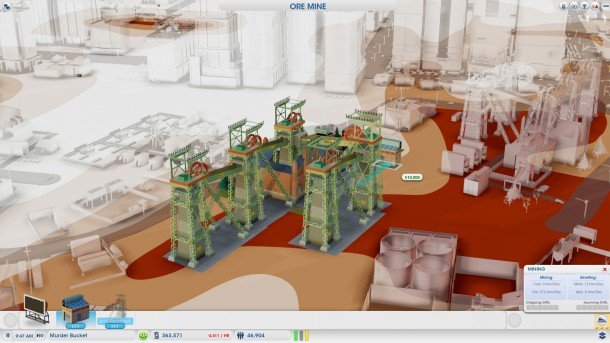
I really like the new specialization system. It adds a layer of challenge on top of RCI zoning, adds to the long-term story of a city, and can make you filthy rich if played right.
You don't have to "choose" one specialization—they're just specialized buildings which you can build or not build, and they enable mining operations, raw materials and consumer goods production, Global Market trade, and the development of a tourism industry. Murder Bucket is rich in ore and oil, so I've opted for the dirty job of ripping it out of the earth.
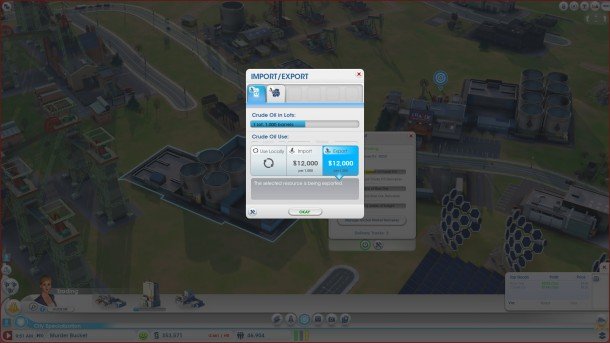
Specialization operations balloon quickly. As I pull ore out of the ground, it needs somewhere to go, so I start building trade depots to sell it on the global market. When I reach a certain daily profit, I unlock the Petroleum HQ, Metals HQ and Trade HQ. Building and upgrading those buildings gives me access to new buildings, such as a smelter which can turn ore into metal or ore and coal into alloys. Now I'm building a supply chain, making sure my trucks can get to and from mines, storage facilities, and processing plants. The more refined my products, the more I can sell them for.
A big part of a city's story is told by its specialization buildings. As mines and oil wells run dry (resources are not infinite), a trade port enables the purchase of raw materials on the Global Market, so I can stay in the refinery business as an importer/exporter instead of sole producer. Or, I can imagine that when the wells dried up, my sad sack Sims turned to booze and gambling. Or maybe the city reinvents itself, investing in cultural landmarks and high-tech industry. I construct a personal story for every city I build, and specializations add context and detail, making my city's past as important as its future.
Interacting with other cities

Every city is built on a plot in one of eight region layouts—the smallest layout has two plots, while the largest two can house 16 cities each. You can keep your region private, or allow others to found cities with you.
The idea is that a successful city can't be successful at everything—and it really can't—so it must live in symbiosis with other cities in its region. If I lack water, for example, I can buy it from another city, and if I see that a city in my region can't handle all its garbage, I can volunteer some of my trucks to help.
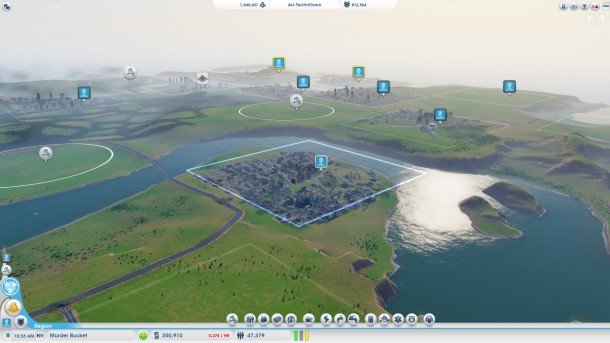
There are also passive benefits. If I have no schools, my population will head to other cities for education. If I have a surplus of low-wealth jobs, unemployed low wealth residents in other cities will hop on my municipal buses and add to my labor force.
Keep up to date with the most important stories and the best deals, as picked by the PC Gamer team.
The idea is exciting, but so far I'm having trouble exploiting it in a meaningful way. I've bought power when I needed a little extra while I saved up for a new plant, but trying to run a city with no power plants does not work. In the screen below, Video Wolf has a 250 MW power surplus, but I'm only buying 20.8 MW despite having a huge power deficit. If I need to upgrade something to increase the amount of power I can purchase, I don't know what it is.
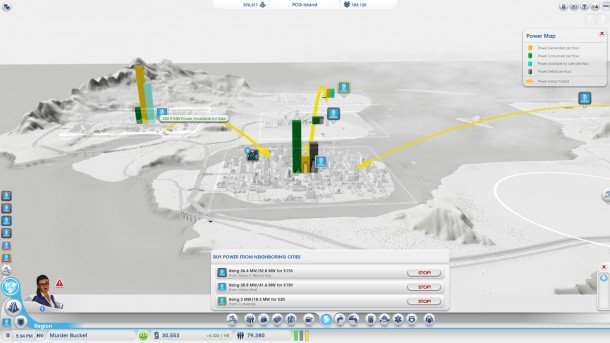
I have the same problem with passive benefits. When one of my cities needed more low-wealth workers, I founded a new city nearby and filled it with low-wealth residential. I tried not to include too much industry, instead focusing on region-wide public transportation, but it didn't really work. The suburban city wouldn't grow like I hoped, and was losing money, so I started building up the commercial sector. That got freight and shoppers in from my first city, but I still hadn't solved the worker shortage. It felt like it was intentionally doing the opposite of what I wanted, though I know the game probably wasn't being vindictive.
It does work in a few places, as long as the region's players are communicating. City Hall upgrades are region-wide, so if I add a Department of Transportation, everyone gains access to advanced transportation buildings. That's really handy.
I'll keep experimenting. I know there's a way to intentionally exploit passive benefits, but I have to dig deeper into the incredibly complex simulation to figure out why one thing works and another doesn't.
The climb to 150,000 residents
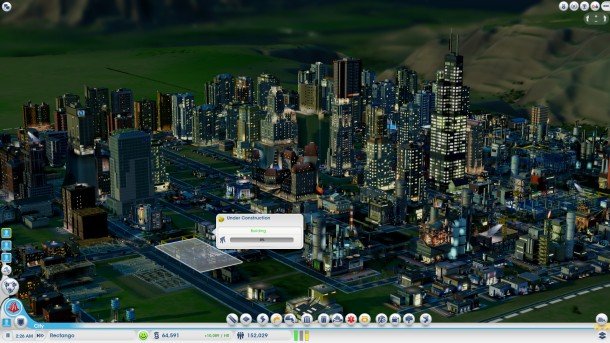
SimCity starts out easy. You lay out a few roads, zone your RCI, plop down a coal plant and water tower, and everything's peachy. Residents are moving in and you're making money—lots of money if you get the RCI ratio right. Low-tech industrial plants have plenty of workers, shops have plenty of customers, and your residents are happy to be both. It doesn't last—SimCity is hard.
As building density increases, your services fail, so you build more and more until your plot is completely gridded, but there's still something wrong. There's always something wrong. As I mentioned in regards to Murder Bucket, the messaging about what's wrong is often confusing, but this cause and effect seesaw keeps the game engaging--the goal might be perfect homeostasis, but if getting there were easy, you'd just be watching. Welcome to Rectango, the city that failed.
Rectango's failed grid

I thought I'd be clever with this one. I crossed the plot with avenues, then plopped roads in nested rectangles. It worked really well at a population of around 38,000, and even at 150,000. In the screen below, I'm raking in cash with ore mines, smelters, and tourist attractions.
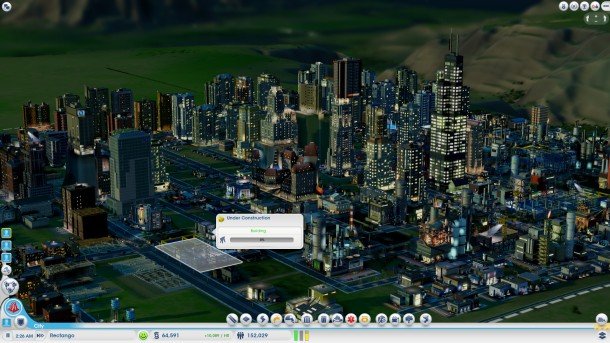
Just before I reached 200,000 residents, however, everything went to hell. I don't know what changed (the wind, maybe?). Traffic from the freeway crawled to a stop, backing up the entire city. Police, health, and fire services couldn't reach anyone, workers couldn't get to jobs, students couldn't get to schools, and everyone was complaining about everything.
So they started leaving (or trying, at least). With businesses closing and my population declining, I went from earning $10,000 an hour to losing $10,000 an hour. I turned off services to save money, but it only made things worse. I had to fix the roads. Below is my embarrassingly haphazard attempt.
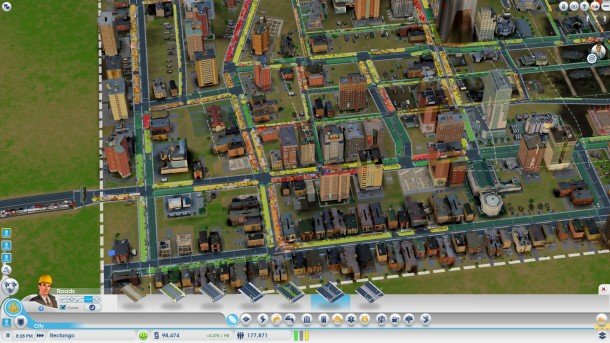
It didn't work, and I've given up on Rectango. I think the tourist attractions, which included Tokyo Tower and a high-capacity expo center, might have done me in, but I'm not completely sure.
Side note: the problem with problems
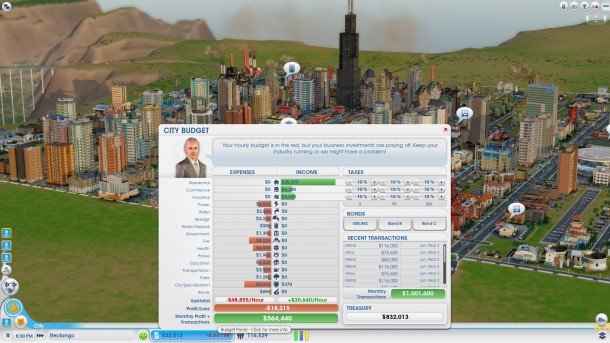
Before I get into Rectango's problems, I'll expand a little more on my issue with SimCity's "advice." Every bit of infrastructure comes with a talking head (what is that beautiful house?) who just loves to nag. Your water pumps are polluted. Waah. Your citizens are getting sick. Boo-hoo. These complaints are all part of the seesaw, but they're also incessant and frustratingly inconsistent.
If you build water pumps near dirty industry, for example, they'll start distributing polluted water. If it's just a little polluted, my pumps will claim that the water is "safe." My advisers and citizens, however, will prod me until I stop what I was doing (something fun, probably) to deal with a tinge of "safe" pollution.
That might be a forgivable matter of word choice, but what's worse is when one business has plenty of places to ship freight to, while its neighbor went out of business for the opposite reason, or when one household loves that there's plenty of shopping, while its neighbors ask "where's the shopping in this town?"
It's confusing, and I wish the Sims were able to identify the cause of their problems so I didn't have to follow them around to figure it out. I love that I can do that, but it takes ages.
On the next page: updates on the always on-line experience

Tyler grew up in Silicon Valley during the '80s and '90s, playing games like Zork and Arkanoid on early PCs. He was later captivated by Myst, SimCity, Civilization, Command & Conquer, all the shooters they call "boomer shooters" now, and PS1 classic Bushido Blade (that's right: he had Bleem!). Tyler joined PC Gamer in 2011, and today he's focused on the site's news coverage. His hobbies include amateur boxing and adding to his 1,200-plus hours in Rocket League.

